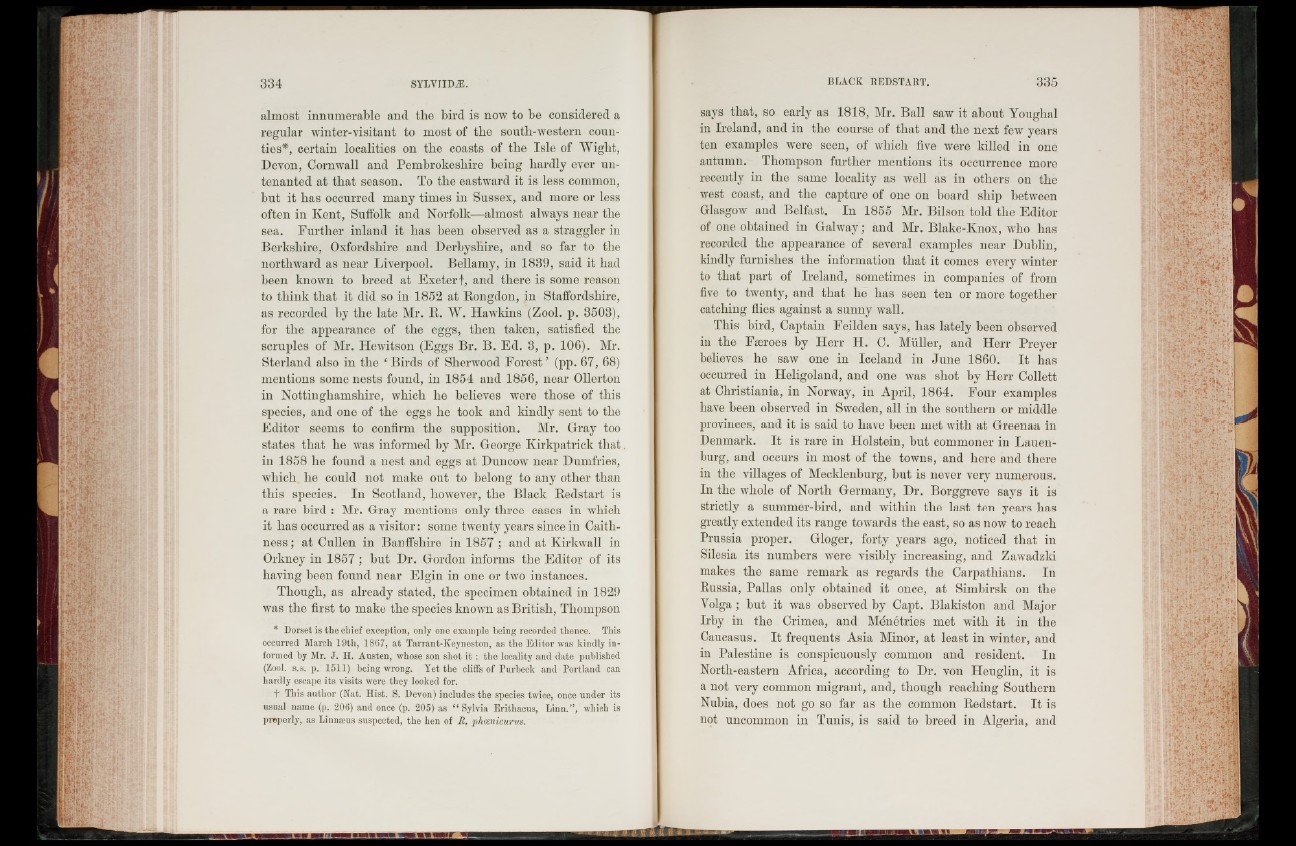
almost innumerable and the bird is now to be considered a
regular winter-visitant to most of the south-western counties*,
certain localities on the coasts of the Isle of Wight,
Devon, Cornwall and Pembrokeshire being hardly ever untenanted
at that season. To the eastward it is less common,
but it has occurred many times in Sussex, and more or less
often in Kent, Suffolk and Norfolk—almost always near the
sea. Further inland it has been observed as a straggler in
Berkshire, Oxfordshire and Derbyshire, and so far to the
northward as near Liverpool. Bellamy, in 1839, said it had
been known to breed at Exeter f, and there is some reason
to think that it did so in 1852 at Rongdon, in Staffordshire,
as recorded by the late Mr. R. W. Hawkins (Zool. p. 3503),
for the appearance of the eggs, then taken, satisfied the
scruples of Mr. Hewitson (Eggs Br. B. Ed. 3, p. 106). Mr.
Sterland also in the ‘ Birds of Sherwood Forest ’ (pp. 67, 68)
mentions some nests found, in 1854 and 1856, near Ollerton
in Nottinghamshire, which he believes were those of this
species, and one of the eggs he took and kindly sent to the
Editor seems to confirm the supposition. Mr. Gray too
states that he was informed by Mr. George Kirkpatrick th a t.
in 1858 he found a nest and eggs at Duncow near Dumfries,
which he could not make out to belong to any other than
this species. In Scotland, however, the Black Redstart is
a rare bird : Mr. Gray mentions only three cases in which
it has occurred as a visitor: some twenty years since in Caithness
; at Cullen in Banffshire in 1857 ; and at Kirkwall in
Orkney in 1857 ; but Dr. Gordon informs the Editor of its
having been found near Elgin in one or two instances.
Though, as already stated, the specimen obtained in 1829
was the first to make the species known as British, Thompson
* Dorset is the chief exception, only one example being recorded thence. This
occurred March 19th, 1867, at Tarrant-Keyneston, as the Editor was kindly informed
by Mr. J. H. Austen, whose son shot it : the locality and date published
(Zool. s.s. p. 1511) being wrong. Yet the cliffs of Purbeck and Portland can
hardly escape its visits were they looked for.
T This author (Nat. Hist. S. Devon) includes the species twice, once under its
usual name (p. 206) and once (p. 205) as “ Sylvia Erithacus, Linn.”, which is
properly, as Linnaeus suspected, the hen of R. phcenicurus.
says that, so early as 1818, Mr. Ball saw it about Youghal
in Ireland, and in the course of that and the next few years
ten examples were seen, of which five were killed in one
autumn. Thompson further mentions its occurrence more
recently in the same locality as well as in others on the
west coast, and the capture of one on board ship between
Glasgow and Belfast. In 1855 Mr. Bilson told the Editor
of one obtained in Galway; and Mr. Blake-Knox, who has
recorded the appearance of several examples near Dublin,
kindly furnishes the information that it comes every winter
to that part of Ireland, sometimes in companies of from
five to twenty, and that he has seen ten or more together
catching flies against a sunny wall.
This bird, Captain Feilden says, has lately been observed
in the Faeroes by Herr H. C. Muller, and Herr Preyer
believes he saw one in Iceland in June 1860. I t has
occurred in Heligoland, and one was shot by Herr Collett
at Christiania, in Norway, in April, 1864. Four examples
have been observed in Sweden, all in the southern or middle
provinces, and it is said to have been met with at Greenaa in
Denmark. It is rare in Holstein, but commoner in Lauen-
burg, and occurs in most of the towns, and here and there
ill the villages of Mecklenburg, but is never very numerous.
In the whole of North Germany, Dr. Borggreve says it is
strictly a summer-bird, and within the last ten years has
greatly extended its range towards the east, so as now to reach
Prussia proper. Gloger, forty years ago, noticed that in
Silesia its numbers were visibly increasing, and Zawadzki
makes the same remark as regards the Carpathians. In
Russia, Pallas only obtained it once, at Simbirsk on the
Volga ; hut it was observed by Capt. Blakiston and Major
Irby in the Crimea, and Mdnetries met with it in the
Caucasus. I t frequents Asia Minor, at least in winter, and
in Palestine is conspicuously common and resident. In
North-eastern Africa, according to Dr. von Heuglin, it is
a not very common migrant, and, though reaching Southern
Nubia, does not go so far as the common Redstart. I t is
not uncommon in Tunis, is said to breed in Algeria, and